 PDF(2453 KB)
PDF(2453 KB)


皱皮粗柄白蚁伞子实体和蚁巢的关联物质分析及氨基酸糖类促生作用初探
王成凤, 刘夏, 张曦予, 董杰, 张实润, 杨晓敏, 吕为, 刘佳艳, 李宗菊
菌物学报 ›› 2025, Vol. 44 ›› Issue (3) : 240256.
 PDF(2453 KB)
PDF(2453 KB)
 PDF(2453 KB)
PDF(2453 KB)
皱皮粗柄白蚁伞子实体和蚁巢的关联物质分析及氨基酸糖类促生作用初探
Analyses of substances associating Termitomyces robustus fruiting bodies with termite nests and preliminary studies on growth-promoting effect of amino acids and sugars
 ,
, 
 ({{custom_author.role_en}}), {{javascript:window.custom_author_en_index++;}}
({{custom_author.role_en}}), {{javascript:window.custom_author_en_index++;}}白蚁伞为云南名贵野生菌,与白蚁互惠共生于白蚁巢中,其子实体的发育至今仍然是一个难解之谜。为了解白蚁伞子实体与蚁巢的物质流,本文应用液相质谱(LC-MS)技术,对皱皮粗柄白蚁伞Termitomyces robustus子实体及其生长基质蚁巢的代谢物谱进行了分析。子实体(JZ)和蚁巢(YC)中共检测到2 023个代谢物,其中JZ特有物质(JZS) 284个,YC特有物质(YCS) 317个,二者共有显著差异物质(GDS) 322个。以相对含量≥0.5的化合物为例,利用Cytoscape (v3.10.0)软件分别展示了43个JZS及YCS中39个物质、29个GDS中19个物质间的显著相关性。KEGG富集到18条共有通路中的40个JZS、YCS及GDS物质,通过氨基酸生物合成及代谢(ABM)、次级代谢产物的生物合成(BSM)及ABC转运3大类通路发生关联。18条通路中,12条与ABM相关,2条与ABC转运中糖代谢相关。选取参与ABM通路的9种氨基酸(苯丙氨酸、异亮氨酸、酪氨酸、脯氨酸、苏氨酸、缬氨酸、色氨酸、亮氨酸、谷氨酸)、参与ABC转运的3种糖(蔗糖、山梨醇、海藻糖)及蚁巢水提液对纯培养菌丝体的促生作用研究表明,每升基础培养基中加入0.2-0.6 g 9种复合氨基酸,20 g葡萄糖+5 g蔗糖或山梨醇或海藻糖、50-150 mL蚁巢水提液,对菌丝体的生长都有显著的促进作用;但添加150 mL蚁巢水提液对菌丝的促生效果显著优于复合氨基酸及糖处理组(0.6 g复合氨基酸+20 g葡萄糖+5 g海藻糖)及复合氨基酸处理组(0.6 g/L复合氨基酸)。284个JZS、317个YCS及322个GDS,特别是以上98个物质在子实体及蚁巢中显著关联,推测其对白蚁伞子实体的发育有重要的调控作用;复合氨基酸及山梨醇或海藻糖对纯培养菌丝体促生效果显著,但次于蚁巢水提液。以上研究为今后进一步分析与白蚁伞子实体生长发育相关的信号分子,探明白蚁伞与白蚁的共生机理,规模化人工培养白蚁伞等提供了理论依据。
Termitomyces robustus is a rare wild fungus in Yunnan, eciprocally symbiotic with termites in termite nests, and the development of its fruiting bodies remains mysterious. In this study liquid chromatography-mass spectrometry (LC-MS) was used to analyze the metabolite profiles of T. robustus fruiting bodies and their growth substrate termite nests. In total, 2 023 metabolites were detected in the fruiting bodies (JZ) and the termite nests (YC), including 284 JZ-specific substances (JZS), 317 YC-specific substances (YCS), and 322 common significantly differential substances (GDS). Citing the compounds with relative content≥0.5 as instance, Cytoscape (v3.10.0) software was used to show the significant correlation among 39 substances in 43 JZS and YCS and 19 substances in 29 GDS. A total of 40 JZS, YCS and GDS substances in 18 common pathways was enriched by KEGG, which were associated through three major categories of pathways, ABM (amino acid biosynthesis and metabolism), BSM (biosynthesis of secondary metabolites) and ABC (ATP-binding cassette) transporters. Among the 18 pathways, 12 were related to ABM and 2 were related to glucose metabolism in ABC transporters. Nine amino acids (phenylalanine, isoleucine, tyrosine, proline, threonine, valine, tryptophan, leucine, and glutamic acid) involved in the ABM pathway, three sugars (sucrose, sorbitol, and trehalose) involved in ABC transporters, and termite water extract were selected to study the growth-promoting effect of purely cultured T. robustus mycelia, and the results showed that the addition of 0.2-0.6 g 9 complex amino acids, 20 g glucose + 5 g sucrose or sorbitol or trehalose, and 50-150 mL termite nest water extracts in per liter of basal media significantly promoted the growth of mycelia. However, the promoting effect of adding 150 mL termite nest water extracts on mycelial growth was significantly better than that of complex amino acid and sugar treatment (0.6 g complex amino acid + 20 g glucose + 5 g trehalose) and compound amino acid treatment (0.6 g complex amino acid). 284 JZS, 317 YCS and 322 GDS, especially the above 98 substances were significantly correlated to the fruiting bodies and termite nests, and it was speculated that they played an important role in regulating the development of the fruiting bodies of Termitomyces. The complex amino acid, sorbitol or trehalose had a significant effect on promoting the growth of purely cultured mycelia, but they were inferior to the water extract of termite nest. Further analysis of signal molecules related to the growth and development of Termitomyces fruiting bodies is needful, for the purpose of exploring the symbiotic mechanism of Termitomyces and termites, and large-scale artificial cultivation of Termitomyces.
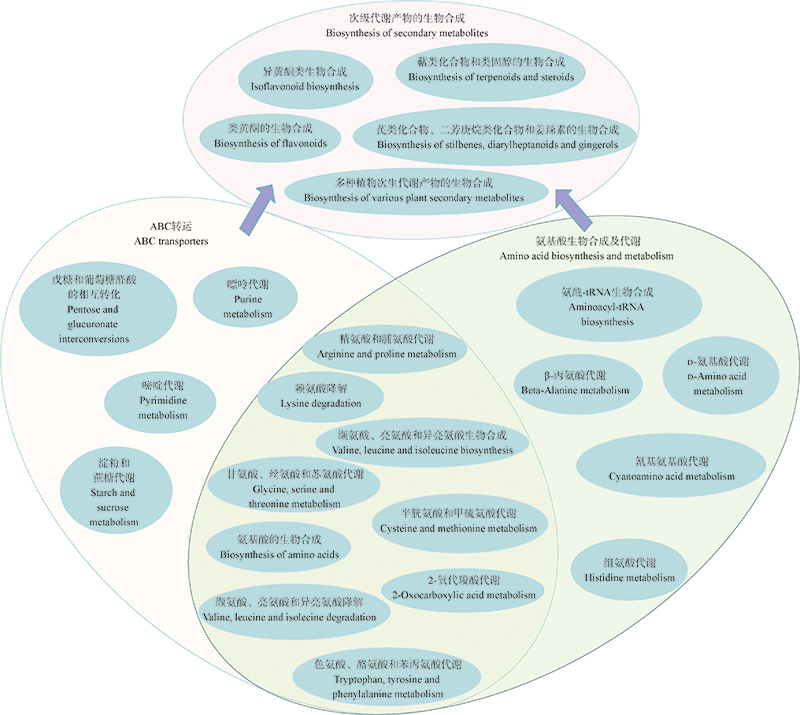
皱皮粗柄白蚁伞 / 蚁巢 / 关联物质 / 关联通路 / 复合氨基酸 / 糖类 / 促生作用 {{custom_keyword}} /
Termitomyces robustus / termite nest / associated substance / associated pathways / complex amino acids / sugars / growth promoting effect {{custom_keyword}} /
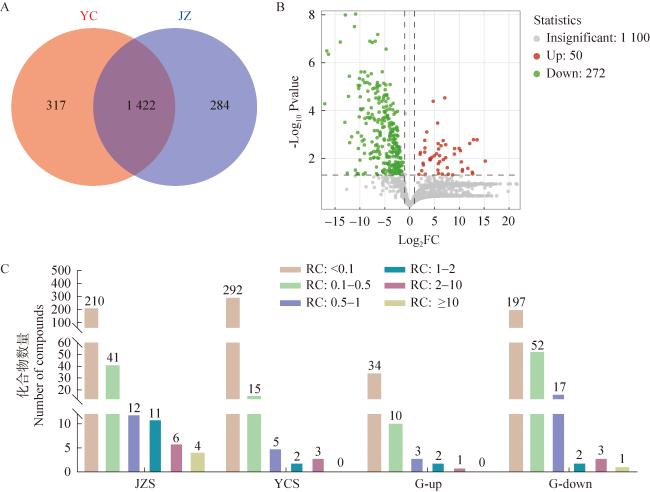
图2 子实体及蚁巢的化合物数 A:JZ及YC的特有物质及共有物质;B:JZ及YC共有上调及下调差异物质的火山图;C:JZ及YC特有物质、共有上调及下调差异物质的含量分段之化合物数;RC:相对含量Fig. 2 Fruiting body (JZ) and termite nest (YC) compounds. A: Specific substances and common substances of JZ and YC; B: Volcanic map of common up-regulated and down-regulated differential substances of JZ and YC; C: The number of compounds of the content segments of specific substances and common up-regulated and down-regulated differential substances of JZ and YC; RC: Relative content. |
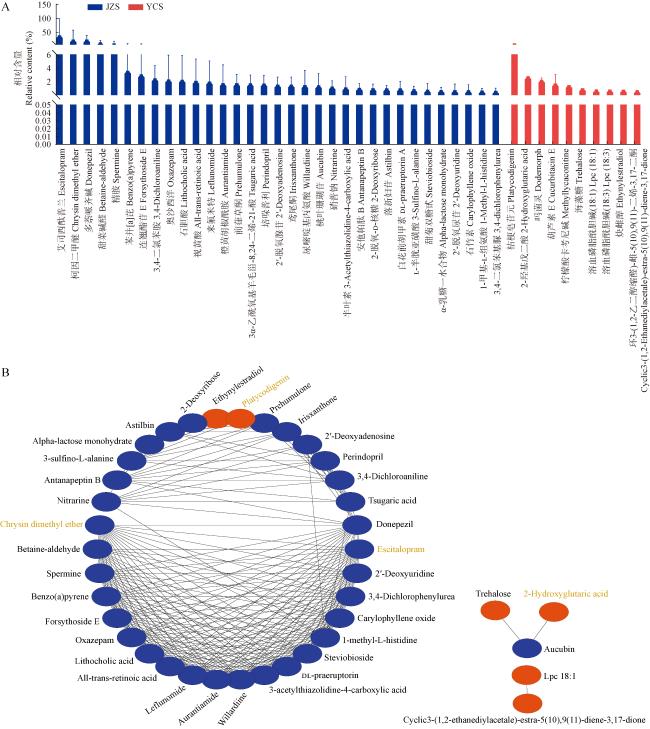
图3 JZS及YCS中43个化合物的含量(≥0.5)及其关系 A:JZS及YCS中43个化合物的含量;B:43个化合物中具有显著相关的39个化合物间之网络关系. 蓝色填充圆圈表示JZS;红色填充圆圈表示YCS;橙色字体为 JZS及YCS中含量前3的4个化合物Fig. 3 Content (≥0.5) and relationships of 43 compounds in JZ-specific substance (JZS) and YC-specific substance (YCS). A: The content of 43 compounds in JZS and YCS; B: Network correlations of 39 compounds with significant correlation among 43 compounds. The blue filled circles represent compounds in JZS; the red filled circles represent compounds in YCS; the orange fonts represent four compounds of the top three content of JZS and YCS. |
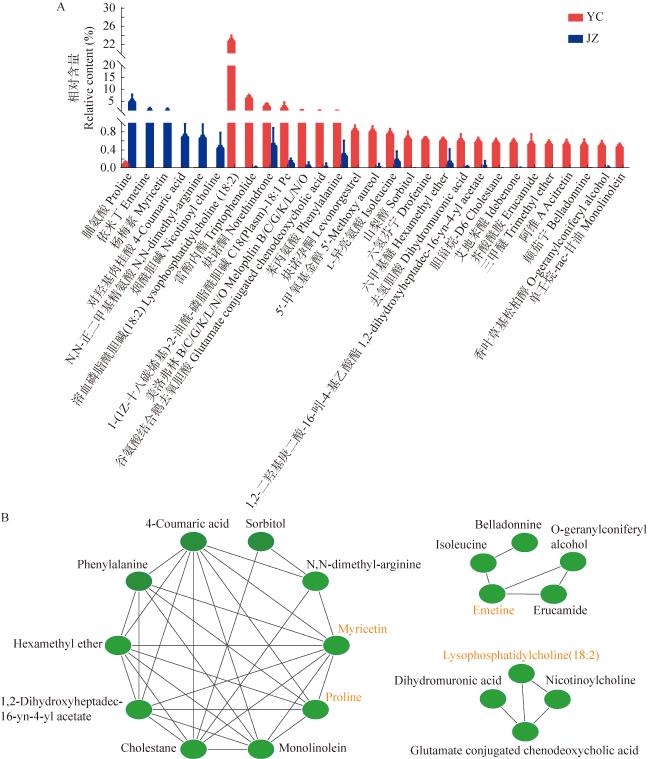
图4 GDS中29个显著差异化合物的含量(≥0.5)及其关系 A:GDS中的29个化合物的含量;B:29个化合物中具有显著相关的19个化合物间的网络关系. 橙色字体表示G-up及G-down中含量居于前3的4个化合物Fig. 4 Content (≥0.5) and relationships of 29 differential compounds in common significantly differential substance (GDS). A: The content of 29 compounds in GDS; B: Network correlations of 19 compounds with significant correlation among 29 compounds. The orange fonts represent four compounds of the top three content of G-up and G-down. |
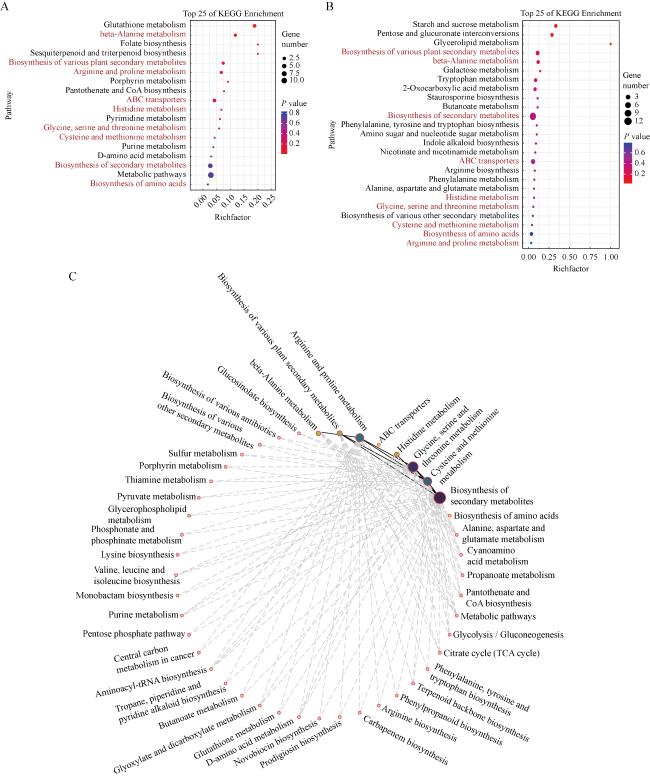
图5 JZS、YCS的富集分析及9条共有通路间网络关系 A:由JZS富集到的通路;B:由YCS富集到的通路;标红的字体为JZS及YCS的共有通路;C:9条共有通路间的关联Fig. 5 Enrichment analyses of JZS and YCS and network relationships among 9 common pathways. A: The pathway enriched by JZS; B: The pathway enriched by YCS; The lettering in red represent 9 common pathways of JZS and YCS; C: Associations among 9 common pathways. |
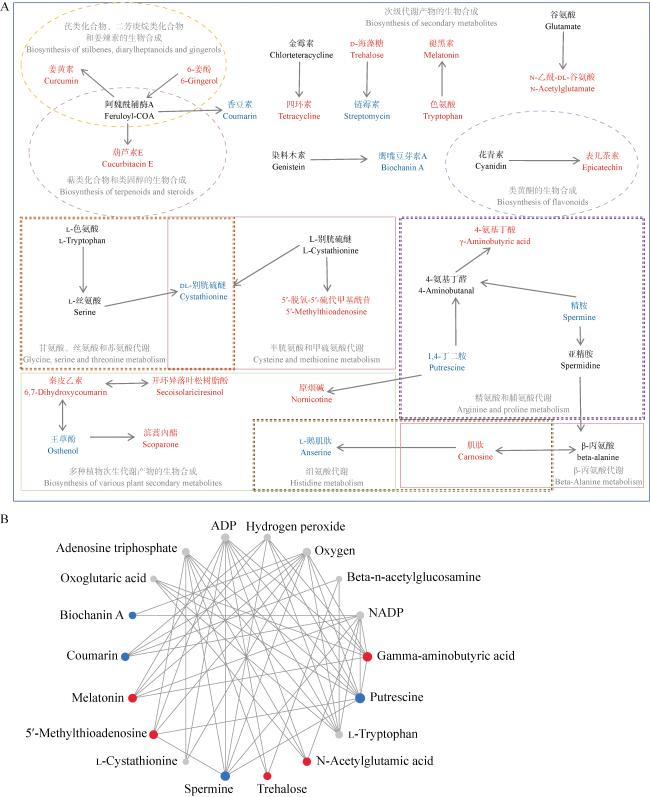
图6 JZS和YCS中7条共有通路的化合物通路及网络关联 A:24个化合物的通路关联;B:24个化合物中匹配到9个化合物的网络关联. 蓝色字体及蓝色实心圆圈为JZS,红色字体及红色实心圆圈为YCSFig. 6 Compound pathways and network associations of 7 common pathways in JZS and YCS. A: Pathway associations of 24 compounds; B: Network associations of 9 compounds matched in 24 compounds; The blue fonts and the blue solid circles represent JZS, and the red fonts and the red solid circles represent YCS. |
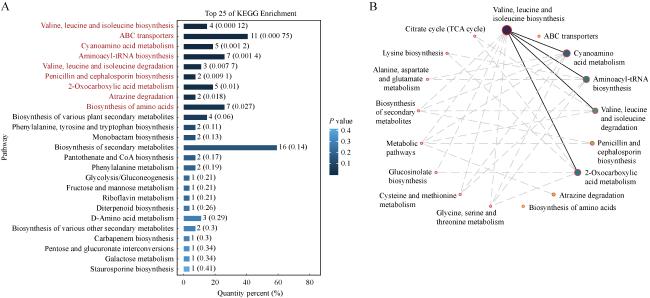
图7 GDS的KEGG富集通路及9条显著差异通路间网络关系 A:前25条富集通路;B:9条显著差异通路间的关联Fig. 7 KEGG enrichment pathways of common differential substances from GDS and the network relationships among 9 significantly differential pathways. A: The top 25 pathways enriched; B: Associations among 9 significantly differential pathways. |
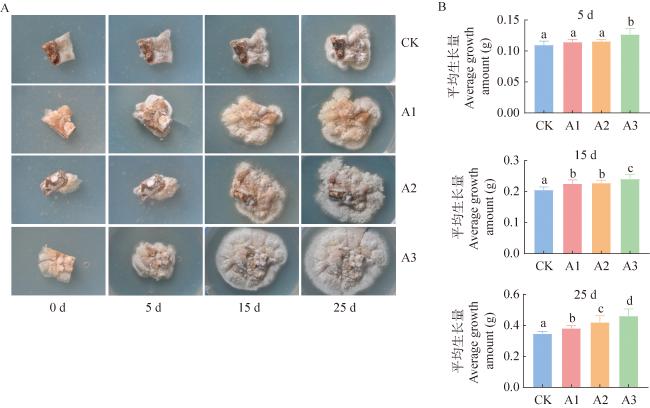
图10 添加复合氨基酸后皱皮粗柄白蚁伞菌丝体不同时期形态特征及生长量 A:5、15及25 d的菌丝体形态特征;B:5、15及25 d的菌丝生长量;CK、A1、A2、 A3分别代表对照组、0.2、0.4、0.6 g/L MAA;相同小写字母表示两者之间无显著差异,不同小写字母表示两者之间P≤0.05;MAA:混合氨基酸母液;下同Fig. 10 Morphological characteristics and growth increment of Termitomyces robustus mycelia in different periods after adding complex amino acids. A: Mycelium morphological characteristics in 5, 15 and 25 d; B: Mycelium growth increment in 5, 15 and 25 d. CK, A1, A2 and A3 represented experimental control, addition of 0.2, 0.4 and 0.6 g/L MAA, respectively; The same lowercase letter means there is no significant difference between the two, and different lowercase letters mean P≤0.05 between the two; MAA: Mixed amino acid mother liquor. The same below. |
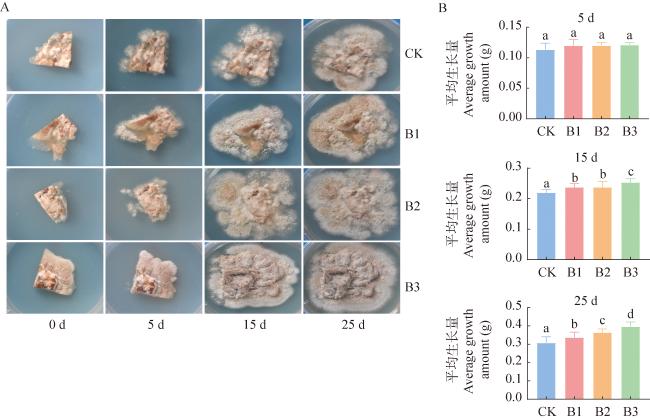
图11 添加3种糖源后皱皮粗柄白蚁伞菌丝体不同时期形态特征及生长量 A:5、15及25 d的菌丝体形态特征;B:5、15及25 d的菌丝生长量;CK、B1、B2、 B3分别代表对照组(2.5%葡萄糖)、2.0%葡萄糖+0.5%蔗糖、2.0%葡萄糖+0.5%山梨醇、2.0%葡萄糖+0.5%海藻糖Fig. 11 Morphological characteristics and growth increment of Termitomyces robustus mycelia in different periods after adding three sugar sources. A: Mycelium morphological characteristics in 5, 15 and 25 d; B: Mycelium growth increment in 5, 15 and 25 d; CK, B1, B2 and B3 represented experimental control (addition of 2.5% glucose), 2.0% glucose+0.5% sucrose, 2.0% glucose+0.5% sorbitol, 2.0% glucose+0.5% trehalose, respectively. |
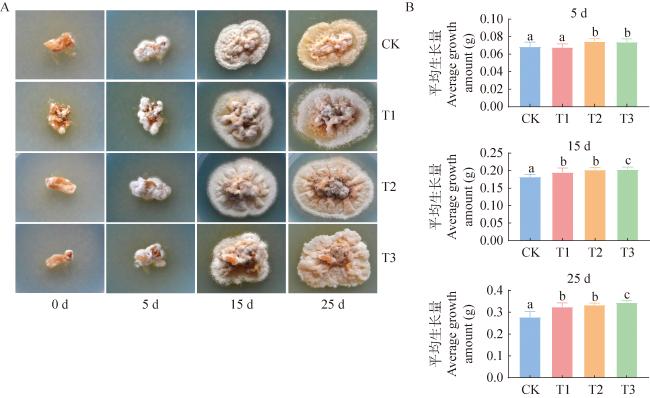
图12 添加蚁巢水提液后皱皮粗柄白蚁伞菌丝体不同时期形态特征及生长量 A:5、15及25 d的菌丝体形态特征;B:5、15及25 d的菌丝生长量;CK、T1、T2、T3分别代表对照组(850 mL BMS+150 mL无菌水)、850 mL BMS+50 mL TNT+100 mL无菌水、850 mL BMS+100 mL TNT+50 mL无菌水、850 mL BMS+150 mL TNT;BMS:基础培养基;TNT:蚁巢水提液Fig. 12 Morphological characteristics and growth increment of Termitomyces robustus mycelia in different periods after adding termite nest water extracts. A: mycelium morphological characteristics in 5, 15 and 25 d; B: Mycelium growth increment in 5, 15 and 25 d; CK, T1, T2 and T3 represented experimental control (850 mL BMS+150 mL sterile water), addition of 850 mL BMS+50 mL TNT+100 mL sterile water, 850 mL BMS+ 100 mL TNT+50 mL sterile water, 850 mL BMS+150 mL TNT, respectively; BMS: Basal medium; TNT: Termite nest water extract. |
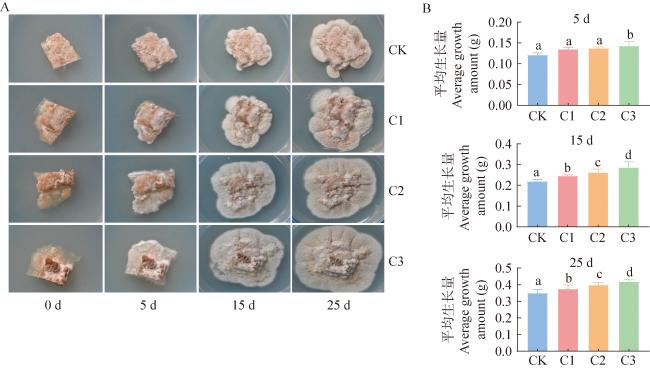
图13 3个比较组皱皮粗柄白蚁伞菌丝体不同时期的形态特征及生长量 A:5、15及25 d的菌丝体形态特征;B:5、15及25 d的菌丝生长量;CK、C1、C2、C3分别代表对照组(基础培养基BMS)、A3 (0.6 g/L MAA)、A3+B3 (0.6 g/L MAA+2.0%葡萄糖+0.5%海藻糖)、T3 (150 mL TNT);MAA:混合氨基酸母液;TNT:蚁巢水提液Fig. 13 Morphological characteristics and growth increment of Termitomyces robustus mycelia in different periods of three comparison groups. A: Mycelium morphological characteristics in 5, 15 and 25 d; B: Mycelium growth increment in 5, 15 and 25 d; CK, C1, C2 and C3 represented experimental control, A3 (0.6 g/L MAA), A3+B3 (0.6 g/L MAA+2.0% glucose+0.5% trehalose), T3 (150 mL TNT), respectively; MAA: Mixed amino acid mother liquor; TNT: Termite nest water extract. |
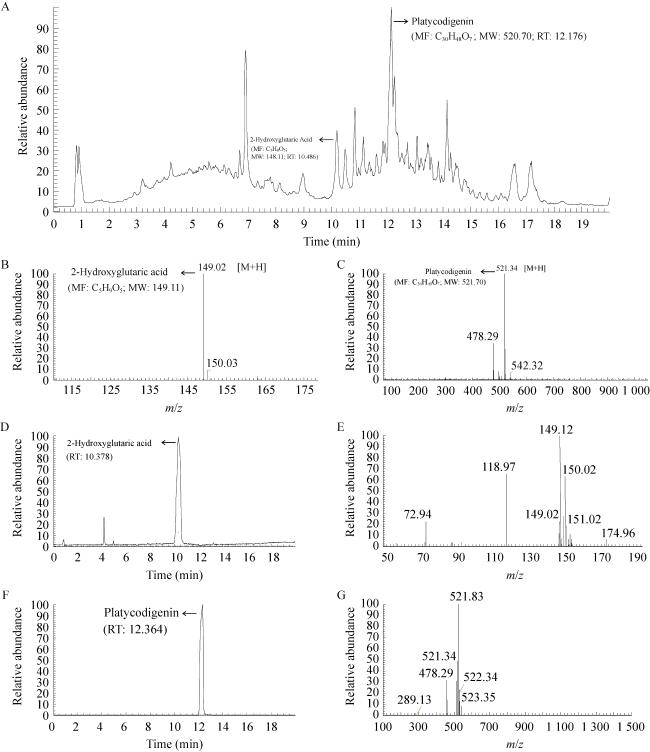
图14 蚁巢(YC)和桔梗皂苷元及2-羟基戊二酸的LC-MS总离子峰谱(TIC)图 A:YC甲醇提取液的TIC;B, C:正离子模式下2-羟基戊二酸及桔梗皂苷元的相对丰度;D, E:2-羟基戊二酸标准品的TIC及相对丰度;F, G:桔梗皂苷元标准品的TIC及相对丰度Fig. 14 Total ion chromatograph (TIC) of termite nest (YC) and platycodigenin and 2-hydroxyglutaric acid. A: TIC of YC methanol extract; B, C: Relative abundance of 2-hydroxyglutaric acid and platycodigenin in positive ion mode; D, E: TIC and relative abundance of 2-hydroxyglutaric acid standards; F, G: TIC and relative abundance of platycodigenin standards. |
| [1] |
{{custom_citation.content}}
{{custom_citation.annotation}}
|
| [2] |
A newer LC-MS/MS method was developed and validated for the simultaneous quantification of raloxifene (RL) and cladrin (CL). Both drugs were resolved in RP-18 (4.6 × 50 mm, 5 μ) Xbridge Shield column using acetonitrile and 0.1% aqueous solution of formic acid (FA) (70:30% v/v) as mobile phase by using biological matrices in female Sprague-Dawley rats using-MS/MS. The developed method was found to be linear over the concentration ranges of 1-600 ng/ml, and lower limit of quantification was 1 ng/ml for RL and CL, respectively. Pharmacokinetic results of RL+CL showed C = 4.23 ± 0.61, 26.97 ± 1.14 ng/ml, at T(h) 5.5 ± 1.00 and 3.5 ± 1.00, respectively. Pharmacokinetic study results will be useful in the future for the combined delivery of RL and CL for osteoporosis treatment.
{{custom_citation.content}}
{{custom_citation.annotation}}
|
| [3] |
{{custom_citation.content}}
{{custom_citation.annotation}}
|
| [4] |
More and more people have recently payed their attention to studies or investigations on medicinal fungi in China. However, many nomenclatural inconsistencies were found in the Chinese reports. The publications on Chinese medicinal fungi were critically reviewed. As a result, 473 medicinal fungi from China were enumerated in the present checklist. All of the names were checked or revised in accordance with the contemporary taxonomy and the latest version of the International Code of Botanical Nomenclature (Vienna Code). The ‘out-of-date’ names, ill-names, and un-existed names and misapplied names in the previous reports were revised. The common synonyms were listed after their valid names. The main medicinal functions of each species, together with the original or important references, were provided.
{{custom_citation.content}}
{{custom_citation.annotation}}
|
| [5] |
{{custom_citation.content}}
{{custom_citation.annotation}}
|
| [6] |
{{custom_citation.content}}
{{custom_citation.annotation}}
|
| [7] |
{{custom_citation.content}}
{{custom_citation.annotation}}
|
| [8] |
{{custom_citation.content}}
{{custom_citation.annotation}}
|
| [9] |
{{custom_citation.content}}
{{custom_citation.annotation}}
|
| [10] |
{{custom_citation.content}}
{{custom_citation.annotation}}
|
| [11] |
{{custom_citation.content}}
{{custom_citation.annotation}}
|
| [12] |
{{custom_citation.content}}
{{custom_citation.annotation}}
|
| [13] |
{{custom_citation.content}}
{{custom_citation.annotation}}
|
| [14] |
{{custom_citation.content}}
{{custom_citation.annotation}}
|
| [15] |
{{custom_citation.content}}
{{custom_citation.annotation}}
|
| [16] |
{{custom_citation.content}}
{{custom_citation.annotation}}
|
| [17] |
{{custom_citation.content}}
{{custom_citation.annotation}}
|
| [18] |
{{custom_citation.content}}
{{custom_citation.annotation}}
|
| [19] |
{{custom_citation.content}}
{{custom_citation.annotation}}
|
| [20] |
{{custom_citation.content}}
{{custom_citation.annotation}}
|
| [21] |
{{custom_citation.content}}
{{custom_citation.annotation}}
|
| [22] |
{{custom_citation.content}}
{{custom_citation.annotation}}
|
| [23] |
{{custom_citation.content}}
{{custom_citation.annotation}}
|
| [24] |
{{custom_citation.content}}
{{custom_citation.annotation}}
|
| [25] |
{{custom_citation.content}}
{{custom_citation.annotation}}
|
| [26] |
{{custom_citation.content}}
{{custom_citation.annotation}}
|
| [27] |
{{custom_citation.content}}
{{custom_citation.annotation}}
|
| [28] |
{{custom_citation.content}}
{{custom_citation.annotation}}
|
| [29] |
{{custom_citation.content}}
{{custom_citation.annotation}}
|
| [30] |
{{custom_citation.content}}
{{custom_citation.annotation}}
|
| [31] |
Fruiting body samples of 10 species of Termitomyces grown in different regions of Sichuan province were analyzed for their amino acid composition using amino acid auto analyzer and Se content using atomic fluorescence spectrometer. The results showed that the contents of total amino acids and essential amino acids were 15.92%-28.86% and 7.08%-10.20%, respectively in the fruiting bodies of the investigated species of the genus Termitomyces. The fruiting bodies of T.albuminosus, T. robustus, T. badius, T. microcarpus, T. schimperi and T. heimi exhibited a total amino acid content of more than 20% and the contents of total amino acids and essential amino acids in T. heimii fruiting bodies were 28.86% and 10.20%, respectively. Besides, Se content of Termitomyces fruiting bodies was 3-18 times higher than that of Xerula radicata, and the Se content of T. badius was (1.2286 ± 0.0340)μg/g. It could be concluded that the 10 investigated species of Termitomyces grown in Sichuan province are rich in a variety of amino acids and Se and are highly nutritious.
{{custom_citation.content}}
{{custom_citation.annotation}}
|
| [32] |
常婷婷, 赵妍, 杨焕玲, 宋晓霞, 董沁, 陈明杰, 2022. 香菇复配氨基酸培养基优化及其对香菇菌丝生长生理的影响. 微生物学通报, 49(2): 545-555
{{custom_citation.content}}
{{custom_citation.annotation}}
|
| [33] |
陈实, 杜贺, 尹君君, 黄超斌, 覃天乔, 黄超福, 李志强, 2021. 培菌白蚁与鸡枞菌研究进展. 环境昆虫学报, 43(3): 642-650
{{custom_citation.content}}
{{custom_citation.annotation}}
|
| [34] |
戴玉成, 杨祝良, 2008. 中国药用真菌名录及部分名称的修订. 菌物学报, 27: 801-824
{{custom_citation.content}}
{{custom_citation.annotation}}
|
| [35] |
杜冰雪, 2022. 木薯蚕蛹虫草培养及其代谢组学研究. 海南大学硕士论文, 海口. 1-49
{{custom_citation.content}}
{{custom_citation.annotation}}
|
| [36] |
付凯, 2014. 桔梗皂苷元提取分离及活性研究. 吉林农业大学硕士论文, 长春. 1-57
{{custom_citation.content}}
{{custom_citation.annotation}}
|
| [37] |
付前发, 王晓东, 王菊琼, 杨军, 王小丹, 张玉, 黎勇, 2013. 黑鸡枞菌的分离纯化及固液体培养特性研究. 食用菌, 2013(4): 18-19
{{custom_citation.content}}
{{custom_citation.annotation}}
|
| [38] |
付子艳, 李荣春, 2009. 鸡枞菌属与华鸡枞属分类研究现状. 广西植物, 29(1): 32-38
{{custom_citation.content}}
{{custom_citation.annotation}}
|
| [39] |
傅秀敏, 唐劲驰, 杨子银, 2021. 茶叶类胡萝卜素合成、代谢调控研究进展. 广东农业科学, 48(5): 18-27
{{custom_citation.content}}
{{custom_citation.annotation}}
|
| [40] |
胡尚勤, 刘天贵, 李贤柏, 2006. 鸡枞菌最佳碳源与生长条件的研究. 食用菌, 2006(3): 11-12
{{custom_citation.content}}
{{custom_citation.annotation}}
|
| [41] |
黎勇, 孙明伟, 杜婉婷, 邓佳, 陈慧, 史典义, 2022. 鸡(土从)菌基因组测序和比较基因组分析. 食用菌学报, 29(6): 1-13
{{custom_citation.content}}
{{custom_citation.annotation}}
|
| [42] |
梁丹丹, 李忆涛, 郑晓皎, 陈天璐, 2018. 代谢组学全功能软件研究进展. 上海交通大学学报(医学版), 38(7): 805-810
高通量代谢组学研究的一大难点在于数据的处理和分析。为分析和处理此类数据,各种生物信息学工具应运而生。这些工具能够对复杂高维的数据集进行预处理、物质鉴定、统计分析和结果解释等。该文以代谢组学数据处理与分析的整体流程和方法为基础,对现阶段一些常用的代谢组学全功能软件进行归纳整理,并对4种代表性软件作详细介绍和对比,为代谢组学研究提供工具选择和方法学参考。
{{custom_citation.content}}
{{custom_citation.annotation}}
|
| [43] |
刘芹, 黄保, 胡素娟, 牛森园, 吴杰, 周奥硕, 孔维丽, 2024. 基于非靶向代谢组学的平菇子实体发育过程中菌丝体差异代谢物分析. 中国瓜菜, 37(1): 45-55
{{custom_citation.content}}
{{custom_citation.annotation}}
|
| [44] |
马雅鸽, 马亚宁, 张晓娟, 2015. 鸡枞菌总多酚提取工艺的优化. 食品工业, 36(6): 209-211
{{custom_citation.content}}
{{custom_citation.annotation}}
|
| [45] |
聂晓东, 2011. 鸡枞菌丝体及其皂甙的深层发酵条件的优化. 江南大学硕士论文, 无锡. 1-59
{{custom_citation.content}}
{{custom_citation.annotation}}
|
| [46] |
彭阳翔, 羊晨, 王梦琦, 魏宝阳, 2019. 不同光质对黑皮鸡枞菌子实体生长发育及营养成分的影响. 湖南农业科学, 2019(9): 27-30
{{custom_citation.content}}
{{custom_citation.annotation}}
|
| [47] |
杨焕玲, 查磊, 赵旭, 赵妍, 王倩, 余昌霞, 陈明杰, 2019. 培养基中添加海藻糖对大球盖菇、斑玉蕈菌丝生长的影响. 微生物学通报, 46(5): 1108-1114
{{custom_citation.content}}
{{custom_citation.annotation}}
|
| [48] |
喻敏, 邹涛, 徐昭焕, 平正明, 庞正平, 王建国, 2014. 土白蚁属Odontotermes分子研究进展. 广东农业科学, 41(10): 63-69
{{custom_citation.content}}
{{custom_citation.annotation}}
|
| [49] |
张梦珂, 陈明杰, 余昌霞, 杨焕玲, 董沁, 查磊, 赵妍, 2024. 食用菌挥发性香味物质及分离鉴定技术研究进展. 微生物学通报, 51(10): 3847-3858
{{custom_citation.content}}
{{custom_citation.annotation}}
|
| [50] |
曾大兴, 谢和, 吴龙英, 1999. 几种分离鸡枞菌的方法研究. 山地农业生物学报, 1999(2): 27-29
{{custom_citation.content}}
{{custom_citation.annotation}}
|
| [51] |
朱玉昌, 周大寨, 唐巧玉, 刘晓鹏, 喻启武, 2009. 富硒野生食用菌液体培养条件初步优化. 中国酿造, 2009(4): 61-64
{{custom_citation.content}}
{{custom_citation.annotation}}
|
| [52] |
邹立扣, 潘欣, 2009. 粗柄鸡枞菌总DNA提取及ITS区克隆测序研究. 北方园艺, 2009(6): 217-219
{{custom_citation.content}}
{{custom_citation.annotation}}
|
| [53] |
邹立扣, 潘欣, 岳爱玲, 罗燕, 李蓓, 张悦, 姚琼, 吴琦, 郑林用, 2011. 四川省鸡枞菌氨基酸组成及硒元素含量分析. 食品科学, 32(14): 245-248
采集获得四川省内10种鸡枞菌,利用全自动氨基酸分析仪测定其氨基酸组成及含量,利用原子荧光光度仪分析其硒元素含量,并利用统计学方法进行分析。结果表明:鸡枞菌子实体氨基酸含量高,总氨基酸为15.92%~28.86%,必需氨基酸含量分别为7.08%~10.20%,普通鸡枞、裂纹鸡枞、乌黑鸡枞、谷堆鸡枞、粗柄鸡枞及小鸡枞的氨基酸含量均超过20%,其中谷堆鸡枞总氨基酸及必需氨基酸分别达到28.86%、10.20%。鸡枞菌中硒含量亦较高,为长根菇的3~18倍,其中乌黑鸡枞含量达到(1.2286±0.0340)μg/g。可见四川省鸡枞菌氨基酸种类、硒含量丰富,营养价值高。
{{custom_citation.content}}
{{custom_citation.annotation}}
|
| {{custom_ref.label}} |
{{custom_citation.content}}
{{custom_citation.annotation}}
|
 PDF(2453 KB)
PDF(2453 KB)
 图1 白蚁伞子实体(JZ)和蚁巢(YC)的多元统计学分析 A:PCA得分图;B:置换模型验证;C:OPLS-DA得分图
图1 白蚁伞子实体(JZ)和蚁巢(YC)的多元统计学分析 A:PCA得分图;B:置换模型验证;C:OPLS-DA得分图 图2 子实体及蚁巢的化合物数 A:JZ及YC的特有物质及共有物质;B:JZ及YC共有上调及下调差异物质的火山图;C:JZ及YC特有物质、共有上调及下调差异物质的含量分段之化合物数;RC:相对含量
图2 子实体及蚁巢的化合物数 A:JZ及YC的特有物质及共有物质;B:JZ及YC共有上调及下调差异物质的火山图;C:JZ及YC特有物质、共有上调及下调差异物质的含量分段之化合物数;RC:相对含量 图3 JZS及YCS中43个化合物的含量(≥0.5)及其关系 A:JZS及YCS中43个化合物的含量;B:43个化合物中具有显著相关的39个化合物间之网络关系. 蓝色填充圆圈表示JZS;红色填充圆圈表示YCS;橙色字体为 JZS及YCS中含量前3的4个化合物
图3 JZS及YCS中43个化合物的含量(≥0.5)及其关系 A:JZS及YCS中43个化合物的含量;B:43个化合物中具有显著相关的39个化合物间之网络关系. 蓝色填充圆圈表示JZS;红色填充圆圈表示YCS;橙色字体为 JZS及YCS中含量前3的4个化合物 图4 GDS中29个显著差异化合物的含量(≥0.5)及其关系 A:GDS中的29个化合物的含量;B:29个化合物中具有显著相关的19个化合物间的网络关系. 橙色字体表示G-up及G-down中含量居于前3的4个化合物
图4 GDS中29个显著差异化合物的含量(≥0.5)及其关系 A:GDS中的29个化合物的含量;B:29个化合物中具有显著相关的19个化合物间的网络关系. 橙色字体表示G-up及G-down中含量居于前3的4个化合物 图5 JZS、YCS的富集分析及9条共有通路间网络关系 A:由JZS富集到的通路;B:由YCS富集到的通路;标红的字体为JZS及YCS的共有通路;C:9条共有通路间的关联
图5 JZS、YCS的富集分析及9条共有通路间网络关系 A:由JZS富集到的通路;B:由YCS富集到的通路;标红的字体为JZS及YCS的共有通路;C:9条共有通路间的关联 图6 JZS和YCS中7条共有通路的化合物通路及网络关联 A:24个化合物的通路关联;B:24个化合物中匹配到9个化合物的网络关联. 蓝色字体及蓝色实心圆圈为JZS,红色字体及红色实心圆圈为YCS
图6 JZS和YCS中7条共有通路的化合物通路及网络关联 A:24个化合物的通路关联;B:24个化合物中匹配到9个化合物的网络关联. 蓝色字体及蓝色实心圆圈为JZS,红色字体及红色实心圆圈为YCS 图7 GDS的KEGG富集通路及9条显著差异通路间网络关系 A:前25条富集通路;B:9条显著差异通路间的关联
图7 GDS的KEGG富集通路及9条显著差异通路间网络关系 A:前25条富集通路;B:9条显著差异通路间的关联 图8 化合物通路及网络关联 A:6个氨基酸的通路关联;B:6个氨基酸的network关联
图8 化合物通路及网络关联 A:6个氨基酸的通路关联;B:6个氨基酸的network关联 图9 JZS、YCS及GDS中富集到通路中的氨基酸及糖类物质
图9 JZS、YCS及GDS中富集到通路中的氨基酸及糖类物质 图10 添加复合氨基酸后皱皮粗柄白蚁伞菌丝体不同时期形态特征及生长量 A:5、15及25 d的菌丝体形态特征;B:5、15及25 d的菌丝生长量;CK、A1、A2、 A3分别代表对照组、0.2、0.4、0.6 g/L MAA;相同小写字母表示两者之间无显著差异,不同小写字母表示两者之间P≤0.05;MAA:混合氨基酸母液;下同
图10 添加复合氨基酸后皱皮粗柄白蚁伞菌丝体不同时期形态特征及生长量 A:5、15及25 d的菌丝体形态特征;B:5、15及25 d的菌丝生长量;CK、A1、A2、 A3分别代表对照组、0.2、0.4、0.6 g/L MAA;相同小写字母表示两者之间无显著差异,不同小写字母表示两者之间P≤0.05;MAA:混合氨基酸母液;下同 图11 添加3种糖源后皱皮粗柄白蚁伞菌丝体不同时期形态特征及生长量 A:5、15及25 d的菌丝体形态特征;B:5、15及25 d的菌丝生长量;CK、B1、B2、 B3分别代表对照组(2.5%葡萄糖)、2.0%葡萄糖+0.5%蔗糖、2.0%葡萄糖+0.5%山梨醇、2.0%葡萄糖+0.5%海藻糖
图11 添加3种糖源后皱皮粗柄白蚁伞菌丝体不同时期形态特征及生长量 A:5、15及25 d的菌丝体形态特征;B:5、15及25 d的菌丝生长量;CK、B1、B2、 B3分别代表对照组(2.5%葡萄糖)、2.0%葡萄糖+0.5%蔗糖、2.0%葡萄糖+0.5%山梨醇、2.0%葡萄糖+0.5%海藻糖 图12 添加蚁巢水提液后皱皮粗柄白蚁伞菌丝体不同时期形态特征及生长量 A:5、15及25 d的菌丝体形态特征;B:5、15及25 d的菌丝生长量;CK、T1、T2、T3分别代表对照组(850 mL BMS+150 mL无菌水)、850 mL BMS+50 mL TNT+100 mL无菌水、850 mL BMS+100 mL TNT+50 mL无菌水、850 mL BMS+150 mL TNT;BMS:基础培养基;TNT:蚁巢水提液
图12 添加蚁巢水提液后皱皮粗柄白蚁伞菌丝体不同时期形态特征及生长量 A:5、15及25 d的菌丝体形态特征;B:5、15及25 d的菌丝生长量;CK、T1、T2、T3分别代表对照组(850 mL BMS+150 mL无菌水)、850 mL BMS+50 mL TNT+100 mL无菌水、850 mL BMS+100 mL TNT+50 mL无菌水、850 mL BMS+150 mL TNT;BMS:基础培养基;TNT:蚁巢水提液 图13 3个比较组皱皮粗柄白蚁伞菌丝体不同时期的形态特征及生长量 A:5、15及25 d的菌丝体形态特征;B:5、15及25 d的菌丝生长量;CK、C1、C2、C3分别代表对照组(基础培养基BMS)、A3 (0.6 g/L MAA)、A3+B3 (0.6 g/L MAA+2.0%葡萄糖+0.5%海藻糖)、T3 (150 mL TNT);MAA:混合氨基酸母液;TNT:蚁巢水提液
图13 3个比较组皱皮粗柄白蚁伞菌丝体不同时期的形态特征及生长量 A:5、15及25 d的菌丝体形态特征;B:5、15及25 d的菌丝生长量;CK、C1、C2、C3分别代表对照组(基础培养基BMS)、A3 (0.6 g/L MAA)、A3+B3 (0.6 g/L MAA+2.0%葡萄糖+0.5%海藻糖)、T3 (150 mL TNT);MAA:混合氨基酸母液;TNT:蚁巢水提液 图14 蚁巢(YC)和桔梗皂苷元及2-羟基戊二酸的LC-MS总离子峰谱(TIC)图 A:YC甲醇提取液的TIC;B, C:正离子模式下2-羟基戊二酸及桔梗皂苷元的相对丰度;D, E:2-羟基戊二酸标准品的TIC及相对丰度;F, G:桔梗皂苷元标准品的TIC及相对丰度
图14 蚁巢(YC)和桔梗皂苷元及2-羟基戊二酸的LC-MS总离子峰谱(TIC)图 A:YC甲醇提取液的TIC;B, C:正离子模式下2-羟基戊二酸及桔梗皂苷元的相对丰度;D, E:2-羟基戊二酸标准品的TIC及相对丰度;F, G:桔梗皂苷元标准品的TIC及相对丰度 图15 JZ及YC中关联物质的调控通路
图15 JZ及YC中关联物质的调控通路/
| 〈 |
|
〉 |